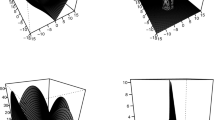Abstract
Despite the fact that the regularisation of multivariate methods is a well-known and widely used statistical procedure, very few studies have considered it from the perspective of analytic matrix decomposition. Here, we introduce a link between one variant of partial least squares (PLS) and canonical correlation analysis (CCA) for multiple groups, as well as two groups covered as a special case. A continuation algorithm based on the implicit function theorem is selected, with particular attention paid to potential non-generic points based on real economic data inputs. Both degenerated crossings and multiple eigenvalues are identified on the paths. The theory of Chebyshev polynomials is applied in order to generate novel insights into the phenomenon simply generalisable to a variety of other techniques.







Similar content being viewed by others
Notes
In terms of their significance in practice, the singular value and eigenvalue decompositions of a real symmetric matrix are identical.
Note that because matrix B is specifically block diagonal in this study, joint processing of its square root and inverse are realised separately for each individual block.
As mentioned above, theory of Lagrange multipliers is standardly used to solve the problem.
Note, for the inductive statistical conclusions, there the transformation should be realised because of relatively high positively skewed data.
References
Batles Z, Trefethen L (2004) An extension of Matlab to continuous functions and operators. SIAM J Sci Comput 25(5):1743–1770
Buja A (1985) Theory of bivariate ACE, Technical report no. 74. Department of Statistics, University of Washington
Bunse-Gerstner A, Byers R, Mehrmann V, Nichols NK (1991) Numerical computation of an analytic singular value decomposition of a matrix valued function. Numer Math 60:1–39
Czech Statistical Office (2017) CSO database (downloaded 2017, October 25). Czech Statistical Office, Prague, Czech Republic. Retrieved from: http://www.czso.cz/csu/czso/statistics
Dhooge A, Govaerts W, Kuznetsov YuA (2003) Matcont: a Matlab package for numerical bifurcation analysis of ODEs. ACM Trans Math Softw 29(2):141–164
Dieci L, Pugliese A (2008) Singular values of two-parameter matrices: an algorithm to accurately find their intersection. Math Comput Simul 79(4):1255–1269
European Statistical Office (2017) Eurostat database (downloaded 2017, November 3). European Statistical Office, Luxembourg, Luxembourg. Retrieved from: http://ec.europa.eu/eurostat/data/database
Gifi A (1990) Nonlinear multivariate analysis. Wiley, New York
Golub GH, van Loan CF (1996) Matrix computations, 3rd edn. The Johns Hopkins University Press, Baltimore
Hoerl AE, Kennard RW (1970) Ridge regression: applications to non-orthogonal problems. Technometrics 12:69–82
Janovská D, Janovský V (2010) The analytic SVD: on the non-generic points on the path. Electron Trans Numer Anal 37:70–86
Janovská D, Janovský V, Tanabe K (2008) An algorithm for computing the analytic singular value decomposition. World Acad Sci Eng Technol 2(11):115–120
Kato T (1976) Perturbation theory for linear operators, 2nd edn. Springer, New York
Krantz S, Parks H (2002) A primer of real analytic functions. Birkhauser, New York
Lax PD (2013) Linear algebra and its applications, 2nd edn. Wiley, New York
Leissa W (1974) On a curve veering aberration. J Appl Math Phys 25:99–111
Malec L (2014) Studying economics and tourism industry relations by smooth partial least squares method depending on parameter. 17th applications of mathematics and statistics in economics. Poland, Jerzmanowice, pp 173–179
Malec L (2016) Some remarks on the functional relation between canonical correlation analysis and partial least squares. J Stat Comput Simul 86(12):2379–2391
Malec L, Abrhám J (2016) Determinants of tourism industry in selected European countries: a smooth partial least squares approach. Econ Res 29(1):66–84
Mehrmann V, Rath W (1993) Numerical methods for the computation of analytic singular value decompositions. Electron Trans Numer Anal 1:72–88
Nakatsukasa Y, Noferini V, Trefethen N (2016) Computing the analytic SVD (downloaded 2018, March 23). University of Oxford and Chebfun developers. Retrieved from http://www.chebfun.org/examples/linalg/AnalyticSVD.html
Oelker M-R, Tutz G (2017) A uniform framework for the combination of penalties in generalized structured models. Adv Data Anal Classif 11(1):97–120
Parkhomenko E, Tritchler D, Beyene J (2009) Sparse canonical correlation analysis with application to genomic data integration. Stat Appl Genet Mol Biol 8:1–34
Ramsay JO, Silverman BW (2002) Applied functional data analysis: methods and case studies. Springer, New York
Seber GAF (2004) Multivariate observations. Wiley, New York
SenGupta A (1991) Generalized correlations in the singular case. J Stat Plan Inference 28:241–245
Takane Y, Hwang H, Abdi H (2008) Regularized multiple-set canonical correlation analysis. Psychometrika 73:753–775
Tenenhaus A, Tenenhaus M (2011) Regularized generalized canonical correlation analysis. Psychometrika 76:257–284
Trefethen LN (2013) Approximation theory and approximation practice. SIAM, Philadelphia
Vinod HD (1976) Canonical ridge and econometrics of joint production. J Econom 4(2):147–166
Wegelin JA (2000) A survey of partial least squares (PLS) methods, with emphasis on two-block case, Technical report no. 371. Department of Statistics, University of Washington
Witten DM, Tibshirani R, Hastie T (2009) A penalized matrix decomposition, with applications to sparse principal components and canonical correlation analysis. Biostatistics 10(3):515–534
Wright K (1992) Differential equations for the analytic singular value decomposition of a matrix. Numer Math 63:283–295
Young LJ, Hwang MC (2001) Curve veering phenomena one-dimensional eigenvalue problems. In: Proceedings of the 18th national conference of the Chinese Society of Mechanical Engineers. Taiwan, Taipei, pp 239–246
Acknowledgements
This work was supported by the Grant Agency of Academic Alliance under GA/13/2018.
Author information
Authors and Affiliations
Corresponding author
Additional information
Publisher's Note
Springer Nature remains neutral with regard to jurisdictional claims in published maps and institutional affiliations.
Rights and permissions
About this article
Cite this article
Malec, L., Janovský, V. Connecting the multivariate partial least squares with canonical analysis: a path-following approach. Adv Data Anal Classif 14, 589–609 (2020). https://doi.org/10.1007/s11634-019-00370-x
Received:
Revised:
Accepted:
Published:
Issue Date:
DOI: https://doi.org/10.1007/s11634-019-00370-x
Keywords
- Canonical correlation analysis
- Partial least squares
- Multi-group case
- Analytic singular value decomposition
- Analytic eigenvalue decomposition
- Multiplicity
- Path-following
- Economics




